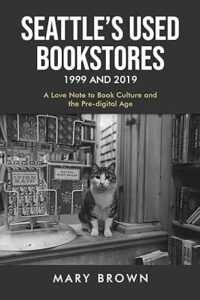Title: Seattle’s Used Bookstores 1999 and 2019: A Love Note to Book Culture And The Pre-Digital Age
Author: Mary Brown
Publisher: Brilliant Books Literary
ISBN: 9798889452935
Pages: 126
Genre: Non-fiction
Reviewed by: Michaela Gordoni
Hollywood Book Reviews
Seattle’s Used Bookstores 1999 and 2019: A Love Note to Book Culture And The Pre-Digital Age is an essay of sorts about used book stores existing and pre-existing in the Seattle area of Washington state, USA. With photographs new and old, it covers the unique characteristics and features of Seattle’s most-loved used bookstores, explaining what makes each of them special. Essentially, it is a biography of the used book culture.
The work is very well-written and well edited. I particularly liked the aptly chosen quotes and learning about the odd bits of information about book store culture. For example, author Mary Brown explains why many of them have cats. According to her, books and cats go hand in hand. The felines are perfect for getting rid of paper-eating mice, and they are drawn to bookshelves, nooks, crannies, and cardboard boxes, all of which make used bookstores ideal stomping grounds. Beyond the feline companionship, she also discusses the harm that comes from viewing digital content instead of paper. It has mental and physical effects, and it’s a very hard market for used booksellers now, which is why many in the Seattle area and all of the world have closed their doors. Mary Brown also talks a bit about Seattle, which, with the rise of tech companies, has changed (mostly for the worse) throughout the years. She also includes a reference list.
Seattle’s Used Bookstores 1999 and 2019: A Love Note to Book Culture And the Pre-Digital Age is sure to strike a chord with readers who appreciate the allure of used books. It’s an ideal book for any bibliophile; as they are hardly bibliophiles if they don’t appreciate used books. It’s short and very relatable. There are still many people who cherish books in their original form and who still appreciate tattered pages and worn covers. The only thing which might have made this book better is if the author allowed a little more emotion and sentiment into the writing and if it covered bookstores up to 2023. It does leave the reader curious about the current state of Seattle’s used bookstores. But all in all, it’s still definitely worth a read, and its scholarly approach does make it more appealing to researchers, students and the younger generations.

